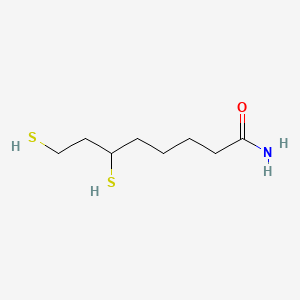| MeSH term | MeSH ID | Detail |
|---|---|---|
| Parkinsonian Disorders | D020734 | 20 associated lipids |
Dihydrolipoamide
Dihydrolipoamide is a lipid of Fatty Acyls (FA) class. Dihydrolipoamide is associated with abnormalities such as Wiskott-Aldrich Syndrome. The involved functions are known as Citric Acid Cycle, Electron Transport, NADH oxidation, Oxidation and Oxidants. Dihydrolipoamide often locates in Mitochondria, Mitochondrial matrix and Chloroplasts. The associated genes with Dihydrolipoamide are Mutant Proteins, Recombinant Proteins, mycothione reductase, Genes, Mitochondrial and alanylproline.
Cross Reference
Introduction
To understand associated biological information of Dihydrolipoamide, we collected biological information of abnormalities, associated pathways, cellular/molecular locations, biological functions, related genes/proteins, lipids and common seen animal/experimental models with organized paragraphs from literatures.
What diseases are associated with Dihydrolipoamide?
Dihydrolipoamide is suspected in and other diseases in descending order of the highest number of associated sentences.
Related references are mostly published in these journals:
| Disease | Cross reference | Weighted score | Related literature |
|---|
Possible diseases from mapped MeSH terms on references
We collected disease MeSH terms mapped to the references associated with Dihydrolipoamide
PubChem Associated disorders and diseases
What pathways are associated with Dihydrolipoamide
There are no associated biomedical information in the current reference collection.
PubChem Biomolecular Interactions and Pathways
Link to PubChem Biomolecular Interactions and PathwaysWhat cellular locations are associated with Dihydrolipoamide?
Visualization in cellular structure
Associated locations are in red color. Not associated locations are in black.
Related references are published most in these journals:
| Location | Cross reference | Weighted score | Related literatures |
|---|
What functions are associated with Dihydrolipoamide?
Related references are published most in these journals:
| Function | Cross reference | Weighted score | Related literatures |
|---|
What lipids are associated with Dihydrolipoamide?
There are no associated biomedical information in the current reference collection.
What genes are associated with Dihydrolipoamide?
Related references are published most in these journals:
| Gene | Cross reference | Weighted score | Related literatures |
|---|
What common seen animal models are associated with Dihydrolipoamide?
There are no associated biomedical information in the current reference collection.
NCBI Entrez Crosslinks
All references with Dihydrolipoamide
Download all related citations| Authors | Title | Published | Journal | PubMed Link |
|---|---|---|---|---|
| Stöckel J et al. | Diurnal rhythms result in significant changes in the cellular protein complement in the cyanobacterium Cyanothece 51142. | 2011 | PLoS ONE | pmid:21364985 |
| Schmidt MC et al. | Efficient α, β-motif finder for identification of phenotype-related functional modules. | 2011 | BMC Bioinformatics | pmid:22078292 |
| Sandoval JM et al. | Glucose-6-phosphate dehydrogenase protects Escherichia coli from tellurite-mediated oxidative stress. | 2011 | PLoS ONE | pmid:21984934 |
| Cruz-GarcÃa C et al. | Fnr (EtrA) acts as a fine-tuning regulator of anaerobic metabolism in Shewanella oneidensis MR-1. | 2011 | BMC Microbiol. | pmid:21450087 |
| Crăiţoiu MM et al. | Clinical and histoenzymatic interrelations of the edentulous ridge's mucosa. | 2011 | Rom J Morphol Embryol | pmid:21424039 |
| Hakansson AP et al. | Apoptosis-like death in bacteria induced by HAMLET, a human milk lipid-protein complex. | 2011 | PLoS ONE | pmid:21423701 |
| Bhaskaran S et al. | Breaking Caenorhabditis elegans the easy way using the Balch homogenizer: an old tool for a new application. | 2011 | Anal. Biochem. | pmid:21354098 |
| Hall BS et al. | Nifurtimox activation by trypanosomal type I nitroreductases generates cytotoxic nitrile metabolites. | 2011 | J. Biol. Chem. | pmid:21345801 |
| Feeney MA et al. | Repurposing lipoic acid changes electron flow in two important metabolic pathways of Escherichia coli. | 2011 | Proc. Natl. Acad. Sci. U.S.A. | pmid:21521794 |
| Vazquez A et al. | Serine biosynthesis with one carbon catabolism and the glycine cleavage system represents a novel pathway for ATP generation. | 2011 | PLoS ONE | pmid:22073143 |
| Natarajan P and Parani M | De novo assembly and transcriptome analysis of five major tissues of Jatropha curcas L. using GS FLX titanium platform of 454 pyrosequencing. | 2011 | BMC Genomics | pmid:21492485 |
| De Britto Mari R et al. | Quantification and morphometry of myenteric neurones in the jejunum of Holtzman rats (Rattus norvegicus). | 2011 | Anat Histol Embryol | pmid:21569076 |
| Stobbe MD et al. | Critical assessment of human metabolic pathway databases: a stepping stone for future integration. | 2011 | BMC Syst Biol | pmid:21999653 |
| Skapski A et al. | Genome-scale analysis of Mycoplasma agalactiae loci involved in interaction with host cells. | 2011 | PLoS ONE | pmid:21966487 |
| de Graaf RM et al. | The organellar genome and metabolic potential of the hydrogen-producing mitochondrion of Nyctotherus ovalis. | 2011 | Mol. Biol. Evol. | pmid:21378103 |
| Liang L et al. | Large scale immune profiling of infected humans and goats reveals differential recognition of Brucella melitensis antigens. | 2010 | PLoS Negl Trop Dis | pmid:20454614 |
| Lu X et al. | The intra- and extracellular proteome of Aspergillus niger growing on defined medium with xylose or maltose as carbon substrate. | 2010 | Microb. Cell Fact. | pmid:20406453 |
| Park YH and Patel MS | Characterization of interactions of dihydrolipoamide dehydrogenase with its binding protein in the human pyruvate dehydrogenase complex. | 2010 | Biochem. Biophys. Res. Commun. | pmid:20385101 |
| Viadas C et al. | Transcriptome analysis of the Brucella abortus BvrR/BvrS two-component regulatory system. | 2010 | PLoS ONE | pmid:20422049 |
| Gutiérrez-Correa J | Trypanosoma cruzi dihydrolipoamide dehydrogenase as target of reactive metabolites generated by cytochrome c/hydrogen peroxide (or linoleic acid hydroperoxide)/phenol systems. | 2010 | Free Radic. Res. | pmid:20815787 |
